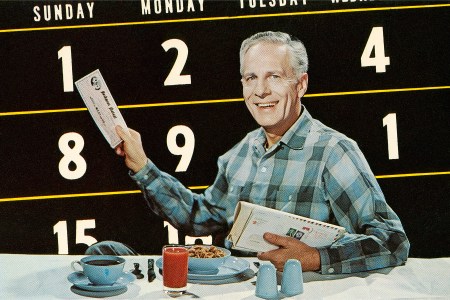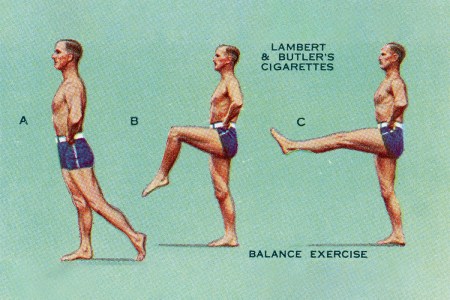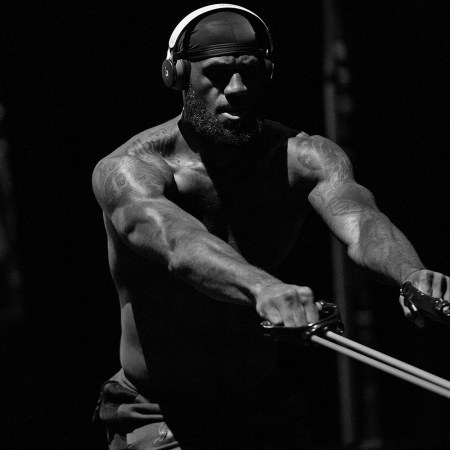I have no clue if this tradition still exists, but when I graduated from high school, all the seniors were locked in the school for an all-night party. There were finger foods and carnival games, meant to cultivate a wholesome atmosphere, though the evening quickly went off the rails. Most of us smuggled schnapps in our underwear to glug on the dance floor, and around 2 a.m., we were all called to the theater for a “surprise performance.”
Anyone with older siblings knew the deal: a hypnotist was going to make our classmates do some crazy shit. Which is precisely what happened — a selection of inebriated and/or exhausted 18-year-olds were lulled to sleep in front of a live audience, then prompted to wobble around like ducks or pretend that their aluminum chair was the driver’s seat of a race car. A male friend of mine became steadily convinced that he’d given birth.
This has long been my understanding of hypnosis: a stage performance exacted on impressionable volunteers, played for maximum laughs. Any updates to this impression haven’t been particularly flattering, either (I’m thinking of Missy Armitage’s “Sunken Place,” in Get Out.) Hypnosis seems either goofy, or ugly, or phony — certainly not a tool to tangibly improve an aspect of one’s wellness. And yet, a growing pile of research indicates that hypnosis could help address a wide variety of health issues. Studies have illustrated the success of “hypnotherapy” in mitigating panic attacks, phobias, irregular sleeping patterns, addictions and gastrointestinal disorders. So: how does the practice work? What does a typical session look like? Could it possibly help you?
Let Breakfast Back Into Your Life
America’s most embattled meal is ready for its comeback. Intermittent fasters be damned.The Case for Hypnosis
According to Begum Uz, a hypnotherapist based in Los Angeles, “Hypnosis opens a gateway to the subconscious mind, allowing us to accept new perceptions and beliefs.”
During a session, Uz carefully guides her patient into a relaxed and receptive state, at which point she’s able to help them “rearrange” past experiences and learned behaviors. Uz finds that this process tends to improve (if not fully alleviate) mind-body issues. Think: chronic pain, sensitive gut issues or a preoccupation with losing weight.
“Hypnosis works great with life improvement issues, such as weight loss or quitting smoking, because most of us have learned associations about [these things] that are not helpful,” she says. “Hypnotherapy helps us subconsciously modify these associations or rescript past events. And when it comes to discomfort, modifying the perception of pain subconsciously can provide significant long-term relief.”
Hypnotherapy geared at nicotine addiction might sound familiar — Nick Kroll told a story about his experience in that underworld in the Netflix special Little Big Boy last year. The comedian says it worked for him, though there isn’t evidence out there that the therapy is any more effective than other available methods. Still, Uz seems to lean into this reality. “There is still not a clear scientific explanation of how and why hypnosis works…but what we know is that during hypnosis, brain waves slow down, and the parts of the brain responsible for cognitive function and emotional regulation light up,” she says.
What’s a “Deepener”?
Carla Bergot was suffering from a severe case of writer’s block when she turned to hypnosis. With deadlines looming, the mystery author remembers feeling desperate and depleted. “I went into it with an open mind and felt totally refreshed afterward,” she says. “My only regret is that I didn’t follow up with additional sessions.”
That “refreshed” feeling traces back, perhaps, to time spent in the theta brainwave state. Similar to losing oneself in a good book, patients will feel their sense of peripheral awareness during a hypnotherapy session. Clinical therapists like Rowena Rowley, who’s based in Lisbon, use this opportunity to “bypass” the conscious mind and communicate directly with her patient’s subconscious. It sounds like mumbo-jumbo, but falls back on techniques that share DNA with meditation and cognitive behavioral therapy.
“[I’m able] to pose direct questions and receive unbiased responses,” Rowley says. “I’m aiming to identify the underlying causes of the client’s issues.” Hypnotherapists like Rowley hold their patients’ hands through the “induction phase” — they might have them try progressive muscle relaxation, then deep breathing (inhale for seven seconds, exhale for 11). Then it’s time to deploy “deepeners.”
The Morpheus Clinic for Hypnosis outlines the most common example: “The hypnotherapist guides the client through a mental image of them descending a staircase…we normally count down from 20 steps, but the exact number isn’t important. At each step, the client is prompted to double their mental relaxation. When they reach the bottom of the staircase, they have reached a very relaxed and calm state. The hypnotherapist counts down the staircase, giving carefully worded recommendations to relax further and let go of worries. When they reach the bottom of the staircase, the deepener is complete.”
15 Mobility Tests to Make Sure You’re Aging A-Okay
From trunk rotations to ankle flexes, these moves are quick, simple and free to tryCreepy Factor
Deepeners can be tailored to each client; they might be vivid walks along a familiar trail, or an imagined nap on a trusty hammock — whatever it takes to imbue a sort of all-encompassing relaxation. From there, the hypnotist has access to the subconscious.
This might come across as, well, a little creepy. Some patients worry about how they’ll behave during a hypnotherapy session or whether they’ll suddenly uncover unwanted memories. But Rowley points out that patients remain “hyper aware” during and after sessions. As for the latter, engaging with anxieties and mucking around in deep-seated trauma is sort of the point. Whatever questions a hypnotherapist asks at this stage is meant to help you understand your triggers, identify the patterns and understand you can change. (For instance: they may urge you to mentally “walk” towards a different trail.)
“With a client’s guidance, positive changes can be introduced to the subconscious mind,” Rowley says. “The effectiveness of very much depends on the individual, their needs and their readiness to embrace positive changes through the acceptance of various suggestions. But the true potential is virtually limitless once one fully acknowledges the immense power of the mind and is truly prepared to harness it.”
An Underrated Alternative
In advance of a major operation 10 years ago, Amy Weirick queued up a number of Hemi-Sync self-hypnosis tapes that her friend had sent her. They worked. “The first surgery I used it for was breast reduction, a very painful surgery,” she says. “But I was able to only take one pain pill by using the self-hypnosis tapes.” They played a series of pings and dings (like binaural beats) and got her through the roughest stretches of recovery.
She used it again for several other surgeries, the Ohio-based PR firm president reports. “My surgeons were stunned at my ability to skip pain meds,” she says. “The first surgeon was super open-minded about letting me listen to it intra-op and in post-op recovery. That’s the time it worked the best. But other surgeons wouldn’t let it in the OR, citing sterilization procedures. It wasn’t quite as effective with those surgeries as pain management, but did pretty well.”
These days, Weirick uses the tapes to relax or fall asleep. Her testimony speaks to the sheer versatility of hypnosis — it can relax brain and body before a life-defining surgery or simply offer a complement to one’s day-to-day cooldown efforts. And if you’re properly prepped (and motivated), you don’t even need to see a hypnotherapist to reap the benefits.
That said — and this would roundly shock my just-graduated self, intent of never quacking in public — there is something appealing about the hypnotherapist’s pitch. Are we not already trying, in a million different ways, to inject some calm and repose into our days? Couldn’t we all stand to benefit from slowing down, from shutting out the periphery for a few minutes, from rediscovering our subconscious? Hypnosis, long maligned and easily misunderstood, deserves a second look.
Whether you’re looking to get into shape, or just get out of a funk, The Charge has got you covered. Sign up for our new wellness newsletter today.


























